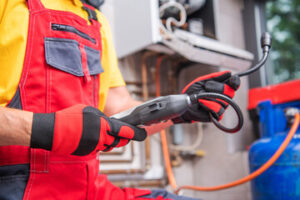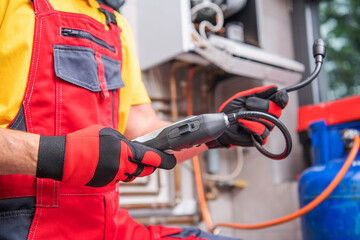Natural gas provides a clean and reliable energy source for many homes. However, it can also be dangerous when it leaks. A leaking gas line can cause fires, explosions, and faulty appliances.

You can prevent these problems by regularly testing your home’s gas lines. This article will cover the basics of Gas Leak Repair so you can take the necessary steps to protect your family.
Detecting a gas leak is the first step in preventing the problem from growing into a disaster. Whether you live in a house in Boston or an apartment in Round Rock, you should know how to identify the symptoms of a gas leak to keep yourself and your family safe.
Turn off the gas at the main valve if you suspect a leak. This is usually in the basement or garage, and it shuts off the entire flow of gas to your home. After the pipe is off, open windows and doors to allow natural gas to vent outside. You may also want to turn off your stove or oven to avoid causing an accidental fire.
Inhaling gas fumes can be dangerous to your health, so you should wear a mask when attempting to locate a leak or perform any maintenance on a damaged line. It is also important to remove any insulated covers that cover the pipes. This will allow you to expose the lines and make it easier for a professional plumber to spot and repair any leaks.
Once you have removed the insulated covers, it’s time to inspect for signs of a gas leak. One of the easiest ways to do this is by using a soap and water solution. Mix a teaspoon of soap with a cup of water to create a concentrated solution, then douse the area where you suspect a leak. Look for bubbles to form – these are the result of escaping gas.
Another way to detect a gas leak is by using test strips. You can purchase these at most hardware stores, and they work by detecting the presence of certain chemicals in the air. The best way to use them is by placing one near a suspected leak and watching for the strip to change color.
If you do discover a gas leak, evacuate the area immediately. Do not light a match, smoke, flip a switch, or use any electronics, including your phone or the home’s alarm system. These actions could trigger sparks that can ignite the leaked gas and cause a large explosion. Once you are a safe distance away from your home, call a plumber for help.
Identifying the Source of the Leak
The good news is that catching a gas leak early can save you time and money. It can also prevent the dangerous effects of carbon monoxide exposure, including nausea and dizziness.
While most of us know to check for leaking gas in our home appliances, it’s not as easy to detect in the gas lines outside your home. A gas leak can occur in the pipes themselves, or at fittings like old shut off valves, tees, unions, flexible supply lines, regulators, and risers. If these connections aren’t tight enough or they get disturbed, they can break down and create a leak. It’s also common for a gas leak to occur where the line runs underground. The pressure in the underground pipe can cause it to break down, or a tree root can get into the line and cause corrosion.
If you suspect a leak, turn off your gas, evacuate the area, and call 911 or your local utility maintenance or emergency service. They can help you identify the source and recommend any repairs needed.
Some signs of a gas leak include stains around your gas pipes, smells in the air, and a hissing or whistling sound coming from nearby appliances. However, not all leaks make a noise, and even if you do find evidence of one, you should always treat it seriously and consult with a professional.
If you have the equipment and skill, it can be relatively easy to pinpoint a leak with a special detection solvent. This is a brightly colored liquid, such as Nu-Calgon fluorescent gas leak solvent, that you spray on a suspected leaking connection or pipe. If there is a leak, bubbles will immediately appear. This can help you locate the exact spot of the leak so you can fix it quickly.
If you want to avoid this step altogether, consider hiring a licensed plumber. A professional can come and inspect your gas lines and equipment for damage, then recommend any needed repairs or replacements. This will give you peace of mind knowing that your home and family are safe from harmful leaks.
Sealing the Leak
Natural gas is a great energy source for our homes, but it can be dangerous if there is a leak. If you notice a gas leak, it is best to leave the area immediately and call a professional plumber. This will allow the plumber to examine and repair the problem before it worsens. A professional can also help you get your gas turned back on, so that you can use your appliances again.
Before you begin the process of repairing a gas leak, make sure that everyone in your home is evacuated and that there are no flames present (including candles and flashlights). Remember, that if there is a gas leak, even the lightest spark can ignite it and set your house on fire. You should also avoid using your cellphone, as it can generate static electricity that could ignite the leaking gas.
Start by turning off the gas supply at your home’s meter or gas main. Once everything is shut off, you should use acetone to clean the high-pressure gas line’s fittings. This step is important, as it will ensure that the sealant used to repair the leak is a good quality one. Then, you can apply epoxy to the leak and seal it completely. Be sure to follow the instructions on the package carefully to ensure that you are applying the epoxy properly.
For low-pressure gas lines, you can use a special product called TridentSeal that is designed to bond with the pipe and repair leaks in a single step. This product uses a high-strength epoxy that penetrates the defect and bonds with the pipe to provide an extremely durable and long-lasting repair.
Finally, for outdoor gas leaks, you can use a product to repair the leak. This is a great alternative to the traditional methods of hammering and soldering, as it doesn’t require any hot work and requires no special tools. It also offers a ten-year warranty, so you can be confident that it will last.
Removing the Leak
If you suspect a gas leak, first ensure that your family members and any other people in the vicinity are at a safe distance. This will prevent any accidental ignition of the gas and keep you from falling victim to a fatal accident should it occur. Once everyone is away from the leaking area, call your state’s natural gas emergency line and/or local fire department. It’s also a good idea to shut off the oven and stove before you begin searching for and repairing a gas leak.
If possible, you should open some windows to let out any trapped gas fumes. Then, locate the gas lines and switch them off by turning the valves behind your stove to the “off” position. Next, locate and shut off any other gas appliances in your home such as fireplaces or outdoor grills. Be sure to shut off the main gas line as well.
A leaking gas line is usually located under a sink or outside near an appliance, such as a water heater. Look around these areas and note any signs of a leak such as dust or dirt blowing in a direction that it doesn’t normally blow, dead plants, discoloured flames when an appliance is turned on, hissing sounds, and bubbles near a gas pipe.
Leaking fuel puddling on the ground is another common sign of a leak. This could be from a car, lawnmower, or other device that has a gas tank attached. If you notice this, it may be time to change the tank.
When removing the tank, make sure you wear a face mask and gloves. It’s also a good idea for you to read the owner’s manual for your device so that you can follow instructions on how to detach and remove the tank.
After you have removed the gas tank, you should clean it using a solvent such as acetone. This will remove any impurities from the gas line and give you a cleaner surface to work on. Once you have cleaned the tank, scuff it with sandpaper to even out the surface and remove any indentations or scratches.
